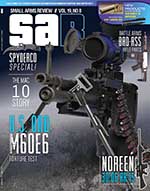Lewis Gun Gunner's Kits
By Robert G. Segel
The iconic Lewis gun, invented by American Isaac Lewis, gained its fame in World War I as the then-new concept of a reliable man-portable light machine gun that the Germans nicknamed “The Belgian Rattlesnake.” Originally made in Belgium in 1914 before that country was overrun by Germany, the tooling was taken to England before capture where it was made by B.S.A. (Birmingham Small Arms) company. It was also made later in the United States by Savage Arms Company. But it was the British manufactured gun that saw the most service in World War I and the British who embraced it as a squad automatic weapon. Though ultimately replaced by the Bren gun as the primary light machine gun between the wars, the Lewis gun remained as secondary armament in the British inventory of small arm weapons and continued service well into World War II in many different capacities.
As an interesting aside, prior to U.S. entry into World War I in 1917, the army used some Savage made Lewis guns along the U.S. and Mexican border during that time in 1917, and the U.S Marines trained with the Lewis gun. When the Marines went to France in 1917 attached to the Army’s 2nd Division, the Lewis guns were taken away and the Marines were issued the French Chauchat M1915 in its stead.
Because the Lewis gun saw such wide service in two world wars, and had such an extended service life, gunner’s kits were a necessary accessory to keep them operational in the field. In World War I the gunner’s kit was a simple leather wallet that contained the bare essentials for the gunner. From lessons learned, the World War II era gunner’s kit was far more compete with a larger canvas carrier that allowed the gunner a wider range of field maintenance.
This article first appeared in Small Arms Review V19N8 (October 2015) |
| SUBSCRIBER COMMENT AREA |
J.David.Truby |
Lewis Guns Forever.... Several Lewis Guns were recovered in Vietnam and I personally recovered one from a guerilla unit in El Salvador in 1986. J David Truby |
| Reply to this comment |
|






